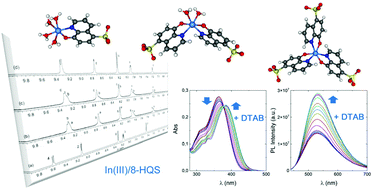Complexes of In(iii) with 8-hydroxyquinoline-5-sulfonate in solution: structural studies and the effect of cationic surfactants on the photophysical behaviour†
Abstract
Following previous studies on the complexation in aqueous solutions of 8-hydroxyquinoline-5-sulfonate (8-HQS) with the trivalent metal ions, Al(III) and Ga(III) and various other metal ions, using multinuclear NMR, DFT calculations, UV-vis absorption and luminescence techniques, we have extended our studies on 8-HQS complexation to the trivalent metal ion In(III). The study combines the high sensitivity of luminescence techniques and the selectivity of multinuclear NMR spectroscopy with the structural details accessible through DFT calculations, and aims to obtain a complete understanding of the complexation between the In3+ metal ion and 8-HQS, and how this influences the luminescence behaviour. A full speciation study has been performed and, as has been reported for the complexes of 8-hydroxyquinoline (8-HQ), the dominant complexes of 8-HQS with In(III) show marked differences in the complexation behaviour when compared with the equivalent complexes with the other group 13 cations Al(III) and Ga(III). While all three complexes have a 1 : 3 (metal : ligand) stoichiometry, those with Al(III) and Ga(III) show a mer-geometry of the ligands around the metal centre, whereas the fac-geometry is observed for the complexes with In(III). On binding to metal ions, 8-HQS shows a marked increase in the intensity of the fluorescence emission band compared to that of the virtually non-luminescent free ligand. However, the increase for In(III) is less pronounced than with Al(III) or Ga(III). These observations have important implications for the application of the complexes in sensing, light emitting devices (e.g. OLEDs), or as electron transport layers in photovoltaics for solar energy conversion. Furthermore, surfactant complexation is known to improve the fluorescence intensity in metal complexes with 8-HQS, by inhibiting the ligand exchange, as we have reported for complexes of HQS with Al(III) and Ga(III). Accordingly, in view of the development of applications in either sensing or optoelectronics, our interest also includes the study of HQS complexes of In(III) in the presence of cationic surfactants, in comparison with previous results with Al(III) and Ga(III).



 Please wait while we load your content...
Please wait while we load your content...